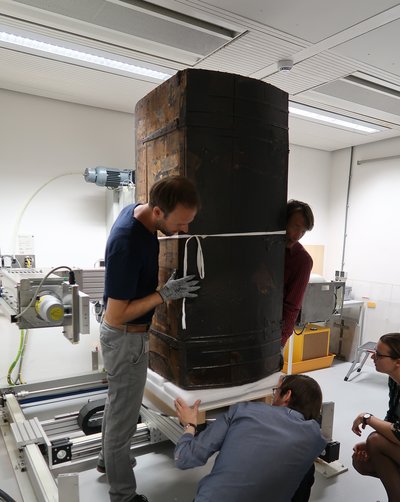It is a question that has puzzled historians and museums for many years: in which book chest did the Dutch humanist and jurist Hugo de Groot escape from Loevestein Castle in 1621? Almost 400 years later, in 2020, a team of researchers from CWI, the Rijksmuseum and the University of Amsterdam set out to find out which of two possible chests could be the real deal. This led to the development of a new scanning technique and an NWO Team Science Award for the researchers.
Documentary
At the time, the search for the real chest was featured in the television documentary Historisch Bewijs, which aired in March 2020. Although neither of the two chests could be ruled out, the research had led to a scientific breakthrough. Researchers at the Rijksmuseum - where one of the book chests is on display - wanted to use tree-ring science (dendrochronology) to determine when the chests were made. They reasoned that if one of the chests was made after the year of the escape, it could be ruled out. But the part of the wood that tree rings are best measured on, was inaccessible. It was covered by other planks, leather or metal fittings.
The researchers wanted to use X-rays to see the tree ring patterns through these coverings without having to remove them. The large size of the chests limited the possibilities of using computed tomography (CT), which prompted the investigation of alternative scanning techniques. Joost Batenburg (CWI/Leiden University) and Francien Bossema of CWI's Computational Imaging group teamed up with dendrochronologist Marta Domínguez Delmás (UvA) and furniture conservator Jan Dorscheid (Rijksmuseum). Their efforts led to the development of a new scanning method for large wooden objects. More information about the technique was discussed in a Historisch Bewijs Extra video.

Team Science Award
In this technique, the object is only moved sideways during scanning (as opposed to being fully rotated in conventional CT). The X-ray images were then processed using customized reconstruction algorithms to produce tomographic images of the cross-section of the wood, in which the annual ring widths could be measured for dendrochronological purposes.

This scientific achievement won the NWO Team Science Award, which recognizes the most inspiring, diverse and successful research team. The research has been published in Scientific Reports and presented at several international conferences. At the Ameridendro 2022 conference in Montreal, Canada, Francien Bossema won the Best Presentation Award (PhD category) for her presentation on the project.
Investigating another imaging technique
Currently, Bossema is at the Getty Museum on a Museum Guest Scholarship. There she is looking for alternative ways to visualize the tree rings in large wooden objects. "For the Hugo de Groot book chest research, we moved the chests from left to right in the scanner. This still posed a challenge because we had to scan the entire length of a plank, which requires high energy X-rays," explains Bossema. "We are now looking at a slightly different imaging technique where the plank is mounted vertically and rotates, but not a full 360 degrees, thus obtaining data at a limited angular range. This is useful because it is often not possible to rotate large objects completely in the CT scanner. We hope to use this to measure the annual rings of flat objects and to date the wood. For example, paintings on wood, where the layer of paint prevents you from seeing the annual rings.”
Bossema is collaborating with Arlen Heginbotham (the J. Paul Getty Museum) and is being advized on this project by fellow Team Science Award winners Dorscheid and Domínguez Delmás. She hopes that another scientific paper will follow if they succeed in recovering the tree rings.
